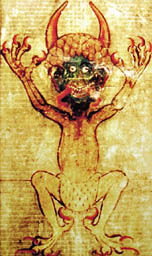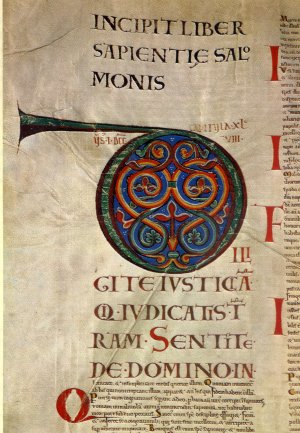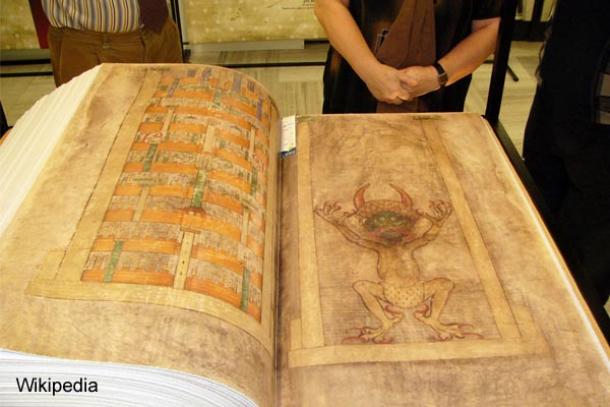
|
|||
The Devils Bible (Codex Gigas) Largest Manuscript in World - Unexplained Mysteries
See more at: http://en.wikipedia.org/wiki/Codex_Gigas
The Codex Gigas (English: Giant Book) is the largest extant medieval manuscript in the world. It is also known as the Devil's Bible because of a large illustration of the devil on the inside and the legend surrounding its creation. It is thought to have been created in the early 13th century in the Benedictine monastery of Podlažice in Bohemia (modern Czech Republic). It contains the Vulgate Bible as well as many historical documents all written in Latin. During the Thirty Years' War in 1648, the entire collection was stolen by the Swedish army as plunder, and now it is preserved at the National Library of Sweden in Stockholm, on display for the general public  Legend According to one version of a legend that is already recorded in the Middle Ages, the scribe was a monk who broke his monastic vows and was sentenced to be walled up alive. In order to forbear this harsh penalty he promised to create in one single night a book to glorify the monastery forever, including all human knowledge. Near midnight he became sure that he could not complete this task alone, so he made a special prayer, not addressed to God but to the fallen angel Lucifer, asking him to help him finish the book in exchange for his soul. The devil completed the manuscript and the monk added the devil's picture out of gratitude for his aid. In tests to recreate the work, it is estimated that reproducing only the calligraphy, without the illustrations or embellishments, would have taken 5 years of non-stop writing. A manuscript like no other, and otherwise known as the Devils Bible because it contains a large and incredibly bizarre illustration of the fallen angel Satan.It is the largest medieval manuscript still in existence, made from over 160 animal skins and at almost a meter long, it takes two people just to lift it. Written in Latin around 1210 AD, the Codex Gigas has brought disaster and pain to all who have possessed it and many others around them, including plague, mental illness, fire and destruction, the story of it's life is filled with mystery and evil.  The manuscript originally had 320 pages, of which, 7 pages have since been removed with no trace, supposedly highly secretive or possibly and more obviously because they contain the monastic rules of the Benedictine monks. Legend has it; that it was completed in just one single night, by an individual monk, condemned to inclusion (to be bricked up alive) for his sins, and aided by selling his soul to the Devil; to help guide his hand and perform this impossible task, he bargained the manuscript against his punishment. Experts have determined that at a writing speed of 20 seconds per line, and many hours of illustration it would have taken close to 30 years to have created the text with a single scribe.
Stories and legends say that the Codex Gigas brought disaster or illness on whoever possessed it during its history. Fortunately, the National Library in Stockholm, where it is currently housed, appears immune to the curse of the codex! Codex Gigas contains a complete vulgate Latin translation of the Bible as well as five other major texts. It begins with the Old Testament and continues with ‘Antiquities of the Jews’ by Flavius Josephus (1st century AD; ‘Encyclopedia Etymologiae’ by Isidore of Seville (6th century AD); a collection of medical works of Hippocrates, Theophilus and others; the New Testament; and ‘The Chronicle of Bohemia’ by Cosmas of Prague (1050 AD).  Smaller texts are also included in the manuscript with the most famous ones including: text on exorcism, magic formulas, a picture of the Heavenly City, and a full page illustration of the Devil. The illustration is the reason why legend says the codex was written with the devil’s help. The details in the Devil After the image of the devil is a page devoted to warding off evil spirits and sickness. On this page are three conjurations and two spells, likely intended as protection from the devil and not an invocation, due to their juxtaposition with the previous page. Further removing an intentional demonic connection is an image of the Heavenly City placed before the demon and the spells. The lack of additional demonic content makes it seem that the image of the devil is present only as a symbol, not as an object of worship. The codex contains nothing else out of the ordinary for the time period. It is the last of a dying breed - one of the final single volume handwritten copies of the Old and New Testament created before moving to an easier to replicate (and carry) multi-volume format. comments powered by Disqus Submit News/Videos/Links | Discuss article | Article Link | More Unsolved and Unexplained Mysteries |
More can be addded on request. Direct your requests at vinit@theunexplainedmysteries.com
